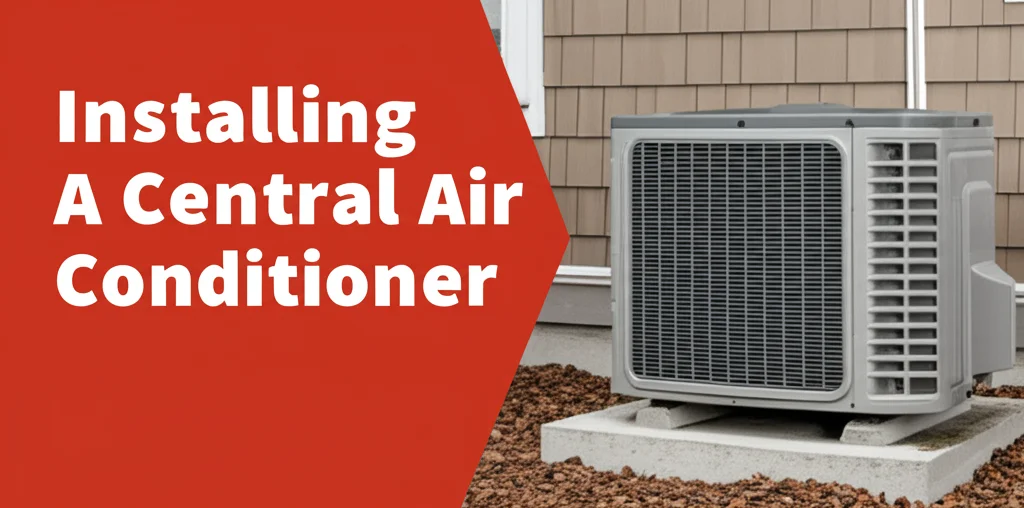· Home Improvement · 7 min read
Installing A Central Air Conditioner

Cool Down Your Home: A Guide to Installing A Central Air Conditioner
Summer heat can be brutal, and a central air conditioner is often the best way to stay comfortable. But what does it take to get one installed? Installing a central air conditioner is a significant home improvement project, and understanding the process is key to a successful outcome. This article will walk you through everything you need to know, from assessing your home’s needs to understanding the costs and deciding if you can tackle the installation yourself. We’ll cover the essential steps, potential challenges, and resources to help you stay cool all season long.
Can you install a central air conditioner yourself?
Generally, installing a central air conditioner is best left to professionals. It involves working with refrigerant, electrical systems, and ductwork, all of which require specialized knowledge and certifications. While experienced DIYers might be able to handle parts of the process, a professional installation ensures safety, efficiency, and warranty coverage.
Understanding Central Air Systems
Before diving into installation, let’s quickly cover what a central air system actually is. A central air conditioning system isn’t just one unit; it’s a network of components working together. The core components include an outdoor unit (the condenser), an indoor unit (the evaporator coil and air handler), and a network of ducts that distribute cool air throughout your home. Refrigerant circulates between these units, absorbing heat from inside your home and releasing it outside. Understanding these parts will help you grasp the installation process.
- Condenser: Located outside, this unit releases heat.
- Evaporator Coil: Located inside, this absorbs heat from the air.
- Air Handler: Circulates air over the evaporator coil.
- Ductwork: Distributes cooled air throughout the house.
Assessing Your Home’s Cooling Needs
Proper sizing is crucial for an efficient and effective central air system. An undersized unit won’t cool your home adequately, while an oversized unit will cycle on and off frequently, leading to uneven temperatures and higher energy bills. To determine the right size, you need to calculate your home’s cooling load. This involves considering factors like square footage, insulation levels, window size and orientation, and climate. You can find online calculators or consult with an HVAC professional for an accurate assessment.
Consider these factors when assessing your cooling needs:
- Square Footage: Larger homes require more cooling power.
- Insulation: Good insulation reduces heat gain.
- Windows: Large or poorly insulated windows increase heat gain.
- Climate: Hotter climates require more powerful systems.
- Sun Exposure: Homes with more sun exposure need more cooling.
The Central Air Installation Process: Step-by-Step
The installation process can seem daunting, but breaking it down into steps makes it more manageable. Here’s a general overview of what’s involved, assuming you’re hiring a professional. First, the technician will assess your home and confirm the system size. Then, they’ll install the outdoor condenser unit on a level concrete pad. Next, the indoor evaporator coil and air handler are installed, often in the attic or a utility closet. Finally, the refrigerant lines are connected, the electrical wiring is completed, and the ductwork is inspected and sealed. A thorough system test ensures everything is working correctly.
Here’s a more detailed breakdown:
- Permitting: Obtain necessary permits from your local building department.
- Condenser Installation: Place the outdoor unit on a level pad.
- Evaporator & Air Handler Installation: Install the indoor components.
- Refrigerant Line Installation: Connect the refrigerant lines between units.
- Electrical Connection: Connect the system to your electrical panel.
- Ductwork Inspection & Sealing: Ensure ducts are properly sealed.
- System Testing: Verify the system is functioning correctly.
Understanding the Costs of Central Air Installation
The cost of installing a central air conditioner can vary significantly depending on several factors. These include the size of the system, the complexity of the installation, the brand and efficiency of the unit, and your location. Generally, you can expect to pay between $3,800 and $7,000 for a complete installation, including the unit and labor. Additional costs may include ductwork modifications, electrical upgrades, and permit fees. Getting quotes from multiple contractors is essential to compare prices and services.
Here’s a breakdown of potential costs:
- Unit Cost: $2,000 - $5,000 (depending on size and efficiency)
- Labor Cost: $1,000 - $2,000
- Ductwork Modifications: $300 - $1,000+
- Electrical Upgrades: $100 - $500+
- Permit Fees: $50 - $200
Ductwork: A Critical Component
Often overlooked, ductwork plays a vital role in the efficiency of your central air system. Leaky or poorly insulated ducts can waste a significant amount of energy, reducing cooling performance and increasing your energy bills. During installation, it’s crucial to inspect your ductwork for leaks and damage. Sealing leaks with mastic sealant or metal tape can significantly improve efficiency. Adding insulation to uninsulated ducts is also a good idea. If your ductwork is old or in poor condition, you may need to consider replacing it. You can learn more about maintaining your ductwork and improving efficiency by reading about how to clean your home’s air ducts.
Here are some ductwork considerations:
- Leakage: Seal any leaks with mastic or metal tape.
- Insulation: Insulate uninsulated ducts.
- Material: Consider replacing old or damaged ducts.
- Size: Ensure ducts are properly sized for the system.
DIY vs. Professional Installation: Making the Right Choice
While some homeowners may be tempted to tackle the installation themselves, it’s generally not recommended. Working with refrigerant requires EPA certification, and improper handling can be dangerous and illegal. Electrical work also requires expertise to ensure safety and code compliance. Furthermore, a professional installation typically comes with a warranty, protecting you from potential issues down the road. If you’re comfortable with basic home repairs, you might be able to assist with some tasks, such as preparing the site or installing the concrete pad, but leave the core installation to the professionals. If you’re looking for ways to improve your home’s air quality, consider checking out how to clean mold from painted walls.
Here’s a quick comparison:
| Feature | DIY Installation | Professional Installation |
|---|---|---|
| Cost | Lower | Higher |
| Expertise | Limited | Extensive |
| Safety | Potential Risk | High |
| Warranty | None | Typically Included |
| Code Compliance | Your Responsibility | Guaranteed |
Frequently Asked Questions (FAQ)
Q: How long does a central air installation typically take? A: A typical installation takes 1-3 days, depending on the complexity of the job and whether any ductwork modifications are needed. Factors like the accessibility of the installation areas and the need for electrical upgrades can also affect the timeline.
Q: What SEER rating should I look for in a central air conditioner? A: SEER (Seasonal Energy Efficiency Ratio) measures cooling efficiency. A higher SEER rating means greater efficiency. The minimum SEER rating currently required is 14, but consider a higher rating (16 or higher) for greater energy savings.
Q: How often should I schedule maintenance for my central air system? A: Annual maintenance is recommended. This includes cleaning the condenser coils, checking refrigerant levels, and inspecting the ductwork. Regular maintenance can extend the life of your system and improve its efficiency.
Q: What if my home doesn’t have existing ductwork? A: Installing ductwork can significantly increase the cost of a central air installation. Consider ductless mini-split systems as an alternative, which don’t require ductwork.
Q: Is financing available for central air installation? A: Many HVAC contractors offer financing options. You can also explore home improvement loans or lines of credit.
Stay Cool and Comfortable
Installing a central air conditioner is a significant investment, but it can provide years of comfortable cooling and improve your home’s value. By understanding the process, costs, and your options, you can make an informed decision and ensure a successful installation. Remember to prioritize safety, consider professional installation, and schedule regular maintenance to keep your system running efficiently for years to come. Don’t forget to also consider how to clean hardwood floors with vinegar to keep your home looking its best after the installation is complete!




